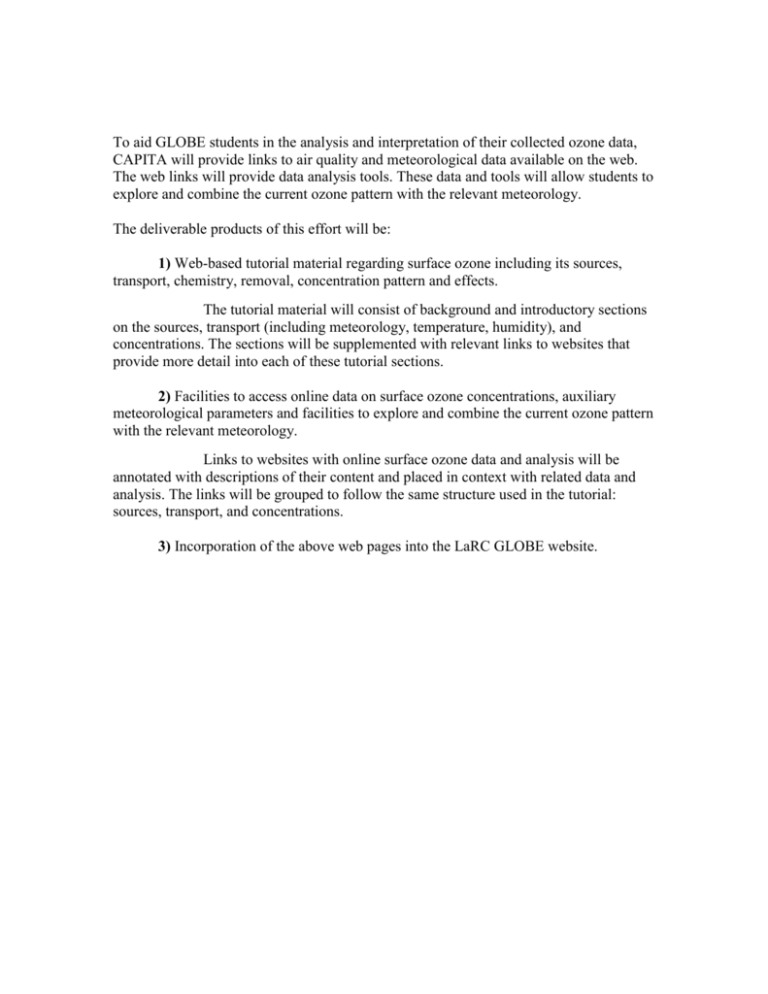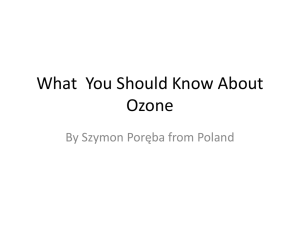StatementofWork
advertisement

To aid GLOBE students in the analysis and interpretation of their collected ozone data, CAPITA will provide links to air quality and meteorological data available on the web. The web links will provide data analysis tools. These data and tools will allow students to explore and combine the current ozone pattern with the relevant meteorology. The deliverable products of this effort will be: 1) Web-based tutorial material regarding surface ozone including its sources, transport, chemistry, removal, concentration pattern and effects. The tutorial material will consist of background and introductory sections on the sources, transport (including meteorology, temperature, humidity), and concentrations. The sections will be supplemented with relevant links to websites that provide more detail into each of these tutorial sections. 2) Facilities to access online data on surface ozone concentrations, auxiliary meteorological parameters and facilities to explore and combine the current ozone pattern with the relevant meteorology. Links to websites with online surface ozone data and analysis will be annotated with descriptions of their content and placed in context with related data and analysis. The links will be grouped to follow the same structure used in the tutorial: sources, transport, and concentrations. 3) Incorporation of the above web pages into the LaRC GLOBE website. Tropospheric Ozone Tutorial What is “good” and “bad” ozone? Ozone occurs in two layers of the atmosphere. The layer surrounding the earth's surface is the troposphere. Here, ground-level or "bad" ozone is an air pollutant that damages human health, vegetation, and many common materials. It is a key ingredient of urban smog. The troposphere extends to a level about 10 miles up, where it meets the second layer, the stratosphere. The stratospheric or "good" ozone layer extends upward from about 10 to 30 miles and protects life on earth from the sun's harmful ultraviolet rays (UV-b) (EPA, Good up High, Bad Nearby). What is ozone? Ozone is a gas that forms in the atmosphere when 3 atoms of oxygen are combined (03). It is not emitted directly into the air, but at ground level is created by a chemical reaction between oxides of nitrogen (NOx), and volatile organic compounds (VOC) in the presence of sunlight.(EPA, Good up High, Bad Nearby) Why do we care about ozone at the surface? Ozone has the same chemical structure whether it occurs high above the earth or at ground level and can be "good" or "bad," depending on its location in the atmosphere. What causes bad ozone? Motor vehicle exhaust and industrial emissions, gasoline vapors, and chemical solvents are some of the major sources of NOx and VOC, also known as ozone precursors. Strong sunlight and hot weather cause ground-level ozone to form in harmful concentrations in the air. Many urban areas tend to have high levels of "bad" ozone, but other areas are also subject to high ozone levels as winds carry NOx emissions hundreds of miles away from their original sources.(EPA, Good up High, Bad Nearby) How is ozone formed? Tropospheric ozone is formed through a chemical reaction between oxides of nitrogen (NOx), and volatile organic compounds (VOC) in the presence of sunlight. For more detailed information refer to Chapter 5, “Atmospheric Chemistry of Ozone and its Precursors” in Rethinking the Ozone Problem in Urban and Regional Air Pollution (1992) (http://books.nap.edu/books/0309046319/html/109.html#pagetop) How does meteorology influence ozone concentrations? Tropospheric ozone is formed most efficiently on hot, sunny days under stagnant and humid air conditions. High humidity and high temperatures enhance the formation of ozone. High winds tend to dilute ozone concentrations locally but they also transport ozone to other locations, often causing high ozone concentrations in areas Low wind speeds lead to the buildup of high local pollutant concentrations (Figure 6a). Strong ventilation with high wind speeds prevents the local build-up near the sources (Figure 6b), but contributes to longrange transport and regional ozone particularly during directionally persistent wind conditions. Can ozone be transported from city to city? Atmospheric conditions can exert a powerful influence on the distribution of pollutant concentrations in space and time. The distance of O3 transport between the precursor emissions and O3 removal is in the range of 150 to 500 miles (Figure 9a). The transport of ozone manifests itself differently at the local, sub-regional and regional scales. In general, local (30-150 miles) transport contributes most to the non attainment of the 120 ppb standard. Beyond 100 - 200 miles the ozone concentrations tend to decrease with increasing transport distances. (OTAG) Concentrations: How is ozone measured? Where are the highest ozone concentrations? When are ozone concentrations highest? Diurnal Seasonal Synoptic--For southern urban areas, where episodes are caused by local stagnation, ozone levels decline rapidly with increasing wind speed (Figure 7a). In northern cities, more heavily influenced by transport, ozone levels decrease much less rapidly, with increasing wind speeds. Tropospheric Ozone Data Sources: What are the precursor emissions? Vehicle Miles Traveled? Transport and Meteorology Topography??: Rel. hum. Temp. Wind Direction/Speed. Trajectories Concentrations: Where is ozone monitored? What do the concentrations mean? - What is high? What is unhealthy? Observations Modeled forecasts. Questions Students can attempt to answer with the above data and analysis: What were the meteorological conditions on a high ozone day? - on a low ozone day? Is the ozone in my area mainly due to NOx or VOC? When are ozone concentrations highest? How do concentrations in my area compare with those in other areas? Is the ozone in my area of local origin or is it transported into the area?






